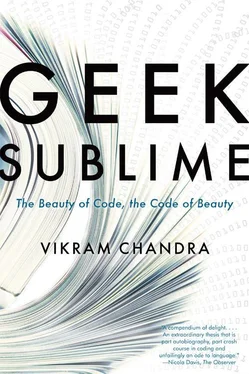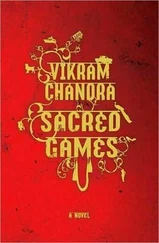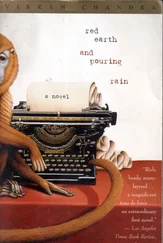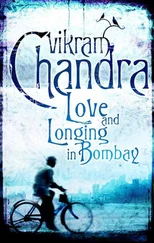
“No being (animal or deity) exists with which man has no affinity of nature,” Abhinavagupta writes.
The saṃasāra (world) is beginningless, and every man, before that which he actually is, has been all the other beings as well. The consciousness of the spectator thus possesses (in other words, is varied by …) the latent impressions of all the possible beings and he is therefore susceptible of identifying himself with each of them. 28
Abhinavagupta’s assertion that “everybody’s mind is indeed characterized by the most various latent impressions” is elsewhere more amenable to a purely materialist interpretation which requires no belief in rebirth; but, always, memory — selves which have been forgotten, experiences suffered and cherished and half-buried — is the limitless pool on which the reverberating dhvani of art enacts its surges and churns out rasa. 29
This susceptibility toward identification with the other, this conjuring up of beings from the endless depths of the self, is what makes
the educative effect ( vyutpādana ) [of poetry] … different from that which comes from scripture through its mandates and from history through its narrations. For in addition to the analogy which it furnishes that we should behave like Rama [and not like Ravana], it produces in the final result an expansion of one’s imagination which serves as the means of tasting the rasas. 30
This expansion of the self is available only through the pleasure of rasa , and so “the end of poetry is pleasure, for it is only by pleasure, in the form of an otherworldly delight, that it can serve to instruct us.” 31
Poetry as moral instruction gets scant attention from the theorists of rasa-dhvani ; when Abhinavagupta does discuss the issue in passing, it is to assure us that
of instruction and joy, joy is the chief goal. Otherwise, what basic difference would there be between one means of instruction, viz., poetry, which instructs after the fashion of a wife, and other means of instruction, such as the Vedas which instruct after the fashion of a master, or history which instructs after the fashion of a friend? That is why bliss is said to be the chief goal. In comparison with [poetry’s] instruction even in all four aims of human life, the bliss which it renders is a far more important goal. 32

To the objection that there was no way to know if rasa really existed, Abhinavagupta replied, “Wrong. It is proved by our own self-awareness, because savouring is a form of knowledge.” 33

The urge to savor is universal, but its expression is culturally shaped. Indian movies mix emotions and formal devices in a manner quite foreign to Western filmgoers; Indian tragedies accommodate comedic scenes, and soldiers in gritty war movies can break into song. According to Anandavardhana:
While it is well known that larger works contain a variety of rasas , a poet who seeks the excellence [of his works] will make just one of them predominant …
[But there is] no obstruction to a single rasa by its being mixed with others … Readers with a ready sense of discrimination, who are attentive and intelligent, will rather take a higher degree of pleasure in such a work. 34
To which Abhinavagupta adds:
If the rasa that has been taken in hand extends throughout the whole plot and is fitted for predominance by this extensiveness, its predominance will not be harmed by the introduction, by the filling in, of other rasas brought in by the needs of the plot and running through only limited sections of the narrative. Rather than being injured, the predominance of the rasa which appears as an abiding factor throughout the plot will be strengthened. In other words, the subsidiary rasas , although they attain a degree of charm by being fully developed each at its own stage by its own set of vibhāvas and the like, still do not attain such a charm that our apprehension will rest on them; rather, it will be carried on to some further delight. 35
A song in an Indian film is an interlude which exists outside of story-logic and story-time, but within the emotional palette of the film; its function is to provide subsidiary rasas that will strengthen the predominant rasa of the whole. The first Indian talkie, Alam Ara (The ornament of the world, 1931), featured seven songs. The newspaper advertisements touted an “all-Star-Cast Production” that was “All Talking/Singing/Dancing.”
This is why the Aristotelian unities of British and American films seemed so alien to me when I watched them as a child. But this emotional monotone was also — implicitly — modern and grownup, as opposed to the premodern and childish sentiment-mixing of our own movies. So, self-consciously serious filmmakers in India have tended to eschew the traditional forms beloved of commercial cinema, and have signaled their noble artistic and political intentions by hewing to conventions native to more “developed” countries.

Anandavardhana gives an example of mixing rasa s from the Mahabharata ; a wife searches for the body of her warrior-husband upon a bloody battlefield, and finds his severed arm:
This is the hand that took off my girdle,
that fondled my full breasts,
that caressed my navel, my thighs, my loins,
and loosened my skirt. 36
Here, the stable emotion of grief is made sharper and more profound by the tasted memory of the erotic. And this provides, for the reader, the savoring of karuna-rasa , pathos.

When I inflict butcheries on the characters in my fictions, I sometimes think about how strange it is that we can savor, even, the horror of battlefields on which entire races die. This is monstrous. We are monstrous.
But savoring is a form of knowledge. And what is most delicious on my palate is a medley of tastes that come together to reveal a dominant rasa. Longer works of fiction that insist on a monotony of emotion always seem awkward to me, incomplete, even if they are elegantly written. But it is not just that the sweet tastes sweetest when placed next to the salty. If savoring is a form of knowledge, then a complexity of affect affords the most to know. I am given pause, I linger, I relish, and I am brought to chamatkara —wonder, self-expansion, awe. When I love a book, a film, a poem, a sentence in a novel, when I am absolutely ravished by it, I always find that my delight is overdetermined, has “more determining factors than the minimum necessary” (as the OED puts it). Where does that “(final) feeling” come from — from the plot, the pace, the words themselves, all those fading memories of the peripheral characters, from the undertones of emotion that I hardly remember? From all of those, at once. From knowing all of those, together.

The theorists of rasa-dhvani gave me a way to think about writer, text, and sahrdaya. I also gained from them a way to think about literary convention — if in poetry “the savouring … arises like a magical flower, having its essence at that very moment, and not connected with earlier or later times,” and also “the feelings of delight, sorrow, etc., [produced by the representation] deep within our spirit have only one function, to vary it, and the representation’s function is to awaken them,” then the claims made for one particular set of conventions — often rather ambitiously called “realism”—are not only epistemically questionable, they are just irrelevant. There are many ways to manifest dhvani , I told my realist writer-friends. Choose the ones that work for you and your sahrdaya , and leave off with the proselytizing and pronouncements of your virtuous artistic rigor, of your deeper connection to what-really-is.
Читать дальше













